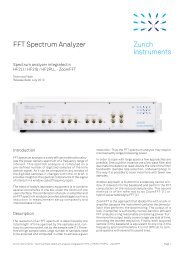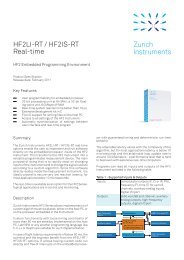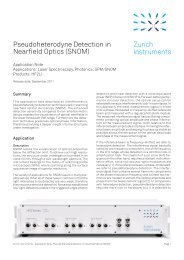Amplitude and Frequency/Phase Modulation - Zurich Instruments
Amplitude and Frequency/Phase Modulation - Zurich Instruments
Amplitude and Frequency/Phase Modulation - Zurich Instruments
Create successful ePaper yourself
Turn your PDF publications into a flip-book with our unique Google optimized e-Paper software.
Pictorial representation of sideb<strong>and</strong>s Electrical engineers know that the FM signal with ϕ(t)<br />
given by eq. (1.7) has a frequency spectrum consisting of an infinite number of sideb<strong>and</strong>s at ω c ± nω m<br />
<strong>and</strong> the amplitude of the n-th sideb<strong>and</strong> is given by the n-th Bessel function. Is there an intuitive<br />
picture of this?<br />
The demodulated signal d FM (t) = Ae jϕFM(t) has constant amplitude, so it describes a phasor<br />
that moves on a circle of radius A: let us take A = 1. For a small phase swing, Fig. 1.4a, one<br />
can neglect the curvature of the circle <strong>and</strong> two terms only are sufficient to approximate d FM (t): an<br />
horizontal time independent phasor b 0 (h) = 1 <strong>and</strong> a vertical phasor that has the same time periodicity<br />
as ϕ FM (t) ∝ sin(ω m t).<br />
We now need to find its amplitude b 1 (h). Let τ ≡ ω m t: for small ϕ FM (τ), one has d FM (τ) =<br />
e jϕFM(τ) ≈ 1 + jϕ FM (τ) <strong>and</strong> the imaginary (i.e. vertical) component is approximated by<br />
b 1 (h) sin τ ≈ Im[d FM (t)] ≈ ϕ FM (τ) ≡ h sin τ.<br />
This small angle limit, usually taken for h < 0.2, is called narrow b<strong>and</strong> FM by the engineers.<br />
a) b)<br />
c) d)<br />
Figure 1.4: The FM signal <strong>and</strong> its decomposition in terms of the Bessel functions.<br />
With large angle<br />
√<br />
modulations (large h), this approximation fails, because the length of the approximated<br />
phasor b 2 0 (h) + b2 1 (h) sin2 τ ≈ 1 + h2<br />
2 sin2 τ = 1 + h2<br />
4<br />
[1 − cos(2τ)] changes twice per cycle of<br />
the phasor, see Fig. 1.4b. One could compensate for this overshoot with the additional term b 2 (h) in<br />
the horizontal direction, Fig. 1.4c. Since the b 2 (h) correction has to take place twice per cycle, it must<br />
have a cos(2τ) dependence. We conclude that b 2 (h) cos(2τ) is the second set of sideb<strong>and</strong>s at ±2ω m .<br />
However at τ = 0, π, b 2 (h) has a contribution towards positive x, <strong>and</strong> b 0 (h) = 1 − b 2 (h) must be<br />
smaller than 1 to make the unit phasor, see Fig. 1.4d. Therefore the conditions on b 0 (h) <strong>and</strong> b 2 (h) are<br />
{<br />
b 0 (h) + b 2 (h) = 1 when τ = 0<br />
b 0 (h) + b 2 (h) cos(2τ) = cos ϕ FM (τ) −→<br />
b 0 (h) − b 2 (h) = cos(h) when τ = π<br />
6





